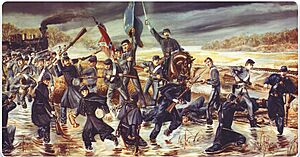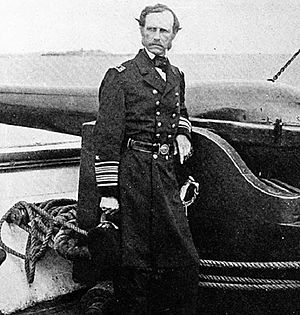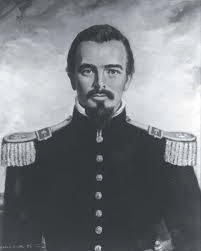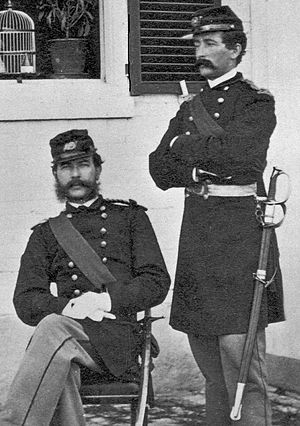Battle of Tulifinny facts for kids
Quick facts for kids Battle of Tulifinny |
|||||||
|---|---|---|---|---|---|---|---|
| Part of the American Civil War | |||||||
|
|||||||
| Belligerents | |||||||
| Commanders and leaders | |||||||
| Maj.Gen. John G. Foster RAdm John A. Dahlgren CDR George H. Preble 1LT George G. Stoddard |
Maj.Gen. Sam Jones | ||||||
| Units involved | |||||||
| South Atlantic Blockading Squadron | |||||||
| Strength | |||||||
| approx 5,000 | approx 900 | ||||||
The Battle of Tulifinny was a fight during the American Civil War. It happened from December 6 to 9, 1864, in South Carolina. This battle was part of General Sherman's famous "March to the Sea." Even though they were outnumbered five to one, Confederate soldiers successfully defended a very important railroad line. This railroad connected the cities of Charleston and Savannah.
This battle is special for a few reasons. It was one of the few times that U.S. Marines fought on land during the Civil War. Also, the entire group of students from the South Carolina Military Academy (now The Citadel) fought in this battle. They made up more than a third of the Confederate forces. It is the only time in history that a whole U.S. college student body fought in a real battle.
Contents
Why the Battle Happened
In December 1864, Union Major General William T. Sherman led his large army of about 62,000 soldiers. They were moving towards Savannah, Georgia. Sherman used a tough strategy called "scorched earth." This meant his troops burned farms and homes. They also took or killed livestock and used any available supplies. This harsh method was meant to make Confederate soldiers give up. It also aimed to make the South lose its will to keep fighting.
The Tulifinny area was one of eight places where cadets from the South Carolina Military Academy (SCMA) fought. The Union's goal was to cut the important Charleston-Savannah railroad line. They wanted to destroy a railroad bridge over the Tulifinny River. Union forces, mostly from the U.S. Navy and Marine Corps, landed 5,000 troops. They landed at Gregorie Point, a swampy area near the town of Yemassee. This spot was about 45 miles north of Savannah.
Who Fought in the Battle
This section lists the different groups of soldiers who fought at Tulifinny.
Union Forces
The Union army had about 5,000 soldiers in total.
U.S. Army Units
- 56th New York Infantry Regiment
- 127th New York Infantry Regiment
- 144th New York Infantry Regiment
- 157th New York Infantry Regiment
- 25th Ohio Infantry Regiment
- 3rd New York Light Artillery Regiment Battery F
- 3rd Rhode Island Heavy Artillery Regiment
- 32nd U.S. Colored Troops
- 33rd U.S. Colored Troops
- 102nd United States Colored Infantry Regiment, 34th U.S. Colored Troops
Rear Admiral John A. Dahlgren led the Union Navy ships.
The ships that helped land troops at Tulifinny were:
- USS St Louis
- USS Pawnee
- USS Canandaigua
- USS Flag
- USS New Hampshire
- USS Sonoma
- USS Mingoe
- USS Pontiac
- USS Saratoga
- USS James Adger
- USS Cimarron
- USS Donegal
U.S. Marine Corps
First Lieutenant George G. Stoddard led the U.S. Marines.
Confederate Forces
The Confederate army had about 900 soldiers.
Confederate Army Units
Major General Samuel Jones was in charge.
- 5th Georgia Infantry
- 32nd Georgia Infantry
- 47th Georgia Infantry
- 1st Georgia Reserves
- 3rd Georgia Reserves
- South Carolina Battalion of State Cadets
- Bacon's South Carolina Militia
- Charleston (Bachmann's) German Light Artillery
- 1st South Carolina Artillery (1 Company)
- 3rd South Carolina Cavalry
- Kirk's South Carolina Cavalry Squadron
The Battle Begins
Cadets Arrive
In early December 1864, 343 cadets from the South Carolina Military Academy (SCMA) were sent to defend the state. These cadets came from two schools: the Citadel Academy in Charleston and the Arsenal Academy in Columbia. Major James B. White, who was the head of SCMA, led the cadets.
On December 6, the cadets quickly marched four miles to the railroad bridge at the Tulifinny River. They arrived too late, though. Union troops had already set up positions on Gregorie Point. This put the Union soldiers close enough to attack the railroad bridges. General Jones ordered the cadets to protect the important bridge over the Tulifinny River.
The cadets built trenches and defenses near the bridge. Even without tents, they called their new home "Camp Tulifinny." They took turns guarding the area to prevent a surprise attack. Before sunrise, they learned that Union forces were too close to the railroad. The cadets were ordered to attack and push them back. In the dark, they got their weapons ready and prepared to charge.
Day Two of Fighting
At sunrise on December 7, the cadets and soldiers from the 5th Georgia Infantry moved forward. They were led by Major White. Their goal was to test the strength of the Union forces on a fortified hill. The cadets and Georgia soldiers moved quickly through a field and into a wooded area. When they reached the edge of the woods, they met heavy gunfire.
A cadet named Farish Furman later remembered seeing "a stream of fire shoot out from the bushes." He said a bullet missed his head by inches. The Confederate line shifted and began fighting the entire Union line. The Union soldiers had five regiments spread out in a strong skirmish line. The Confederate troops and cadets used trees for cover and fired heavily at the enemy.
This surprise attack pushed the Union troops back several hundred yards to their original trenches. A Georgia veteran praised the cadets, saying they "fight like Hood's Texicans!" But the attack was costly. Several cadets and teachers were wounded. One cadet, William Patterson, was killed. The rest of that day and through December 8 was spent caring for the wounded. They also guarded captured enemy troops and built more defenses.
Day Three of Fighting
On the morning of December 9, the cadets fought back a strong Union counterattack. A group of U.S. Marines fought on the far right side of the Union line. They attacked the cadets who were at Camp Tulifinny near the railroad bridge. The Union forces were pushed back into their trenches. They were then chased through the thick swamp when their left side gave way. They retreated by following the Tulifinny River south. This was the last attack made by Union forces during the battle.
After the Battle
The cadets stayed at Camp Tulifinny until Christmas. Then they moved to James Island, near Charleston. After the Battle of Tulifinny, the SCMA cadets stayed in the field for five more months. They helped the Confederate Army leave James Island. They marched as far north as Asheville, North Carolina. Then the Governor called them back to South Carolina.
Sherman's troops burned the Arsenal Academy in Columbia during their march. It never reopened. Union forces took over the Citadel Academy when Charleston fell. They stayed there until 1882.
Images for kids









